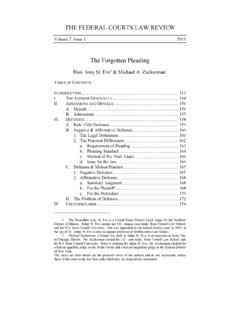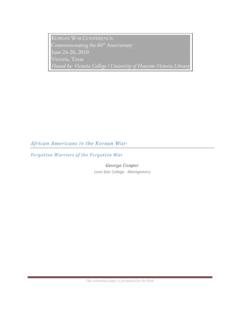Transcription of Book Review The Color of Law: A Forgotten History …
1 Poverty & Race Research Action Council 1200 18th Street NW Suite 200 Washington, DC 20036202/906-8023 FAX: 202/842-2885 E-mail: PaperRichard Rothstein s The Color of 1 Brian Knudsen. A book : A Persistent Public Health 3 Robert Hahn. A major information gap for healthagencies needs a Green and Pleasant 5 Bryan Greene. Harlem at a crossroads in the summer of : The Fight to be 7 Tyler Barbarin. Reimagining the Community 10 Resources .. 15 CONTENTS: April-June 2017 Volume 26: Number 2 Book Review The Color of Law: A Forgotten Historyof How Our Government SegregatedAmerica, by Richard RothsteinBrian KnudsenBrian Knudsen, is Research Associate at the Pov-erty & Race Research Action Council.
2 (Please turn to page 2)When Frank Stevenson came towork in Richmond, California duringWorld War II, he found that little ap-petite existed for residential racial in-tegration. The white residents of ruralMilpitas,California got wind in 1953that the Ford Motor Company plantemploying Stevenson and 250 otherAfrican Americans would be relocat-ing to their town, and they quicklysnapped into action. In a scene thatplayed out in many locales across during the last century, the citi-zens of Milpitas incorporated their cityand passed an emergency exclusionaryzoning ordinance banning apartmentconstruction and allowing only single-family homes. Federal Housing Ad-ministration (FHA) approval, neces-sary to finance construction of low-costsubdivisions in Milpitas and elsewhere,explicitly prohibited home sales toBlacks.
3 With no apartments to rent andexcluded from the single-family mar-ket, for twenty years Stevenson en-dured a daily six-hour round-trip com-mute to and from his residence in Rich-mond California s Black his new book, The Color of Law,Richard Rothstein recounts this andother stories to portray the immensecosts and profound consequences of dejure segregation on African Ameri-cans. De jure segregation, defined assegregation by racially explicit law andpolicy, is a complex system con-structed over decades to perpetuate and in some instances to initiate thespatial separation of whites and Color of Law argues that this typeof residential segregation over thecourse of the twentieth century definedwhere whites and Blacks could live anddenied African Americans access tomiddle-class neighborhoods, with ef-fects continuing to the present.
4 Fur-thermore, Rothstein provocativelyholds that this governmental promo-tion of housing segregation occurringat federal, state and local levels rep-resents a continuing violation of Constitution s Fifth, Thirteenthand Fourteenth Amendments. Finally,Rothstein agrees with past SupremeCourt precedent ( Milliken v. Brad-ley, Parents Involved in CommunitySchools v. Seattle School District, etc.)that the enactment of legal constitu-tional remedies requires showing thatsegregation had governmental , whereas Court decisionsfound no evidence of such state in-volvement, Rothstein sets out in thePoverty & Race (ISSN 1075-3591) is published four times a year by the Poverty andRace Research Action Council, 1200 18th Street NW, Suite 200, Washington, DC 20036,202/906-8052, fax: 202/842-2885, E-mail: info@ Megan Haberle, editor;Tyler Barbarin, editorial assistant.
5 Subscriptions are $25/year, $45/two years. Foreignpostage extra. Articles, article suggestions, letters and general comments are welcome,as are notices of publications, conferences, job openings, etc. for our Resources Section- email to Articles generally may be reprinted, providing PRRAC gives advance permission. Copyright 2017 by the Poverty and Race Research Action Council. All Poverty & Race Vol. 26, No. 2 April-June 2017 Race continues toshape our fraughtcontemporary moment.( Color OF LAW: Cont. from page 2)book to remove any doubt that suchacts took place. Constitutional rem-edies can be placed on the publicagenda, he contends, only after wearouse in Americans an understandingof how we created a system of uncon-stitutional state-sponsored, de jure seg-regation, and a sense of outrage The core chapters of The Color ofLaw provide a descriptive historical ac-count of de jure segregation.
6 Rothsteinseparately discusses each element of dejure segregation, including govern-ment enforcement of racially restric-tive covenants, the use of zoning or-dinances for exclusionary purposes,segregation of public housing,redlining, and explicit racial require-ments in the Federal HousingAdministration s mortgage insuranceprogram. While these topics (and theothers included in the book) have beenfrequently treated separately in priorresearch, perhaps never before nowhave they been so accessibly joinedtogether in this way. This is an im-portant innovation. Amassing all ofthis material together portrays in vividfashion how all-encompassing andmulti-varied were the governmentalefforts to spatially separate the races,and therefore to exclude Blacks fromequal participation in the society,economy and polity.
7 We also learnfrom Rothstein s research so ablypresented in colorful examples and sto-ries that this diverse process playedout over many decades and in innu-merable locations, both small andlarge. Overall, the reader leaves thebook moved and overwhelmed withthe knowledge of the magnitude andcreativity of past efforts to enforcehousing segregation in the , The Color of Law is pub-lished at an opportune moment. Thatthis book appears in the midst of anemerging zeitgeist of race-consciousscholarship and activism is propitious,and Rothstein clearly intends to con-tribute to and build upon this newwork. Following authors such as Ta-Nehisi Coates, Jeff Chang, Keeyanga-Yamahtta Taylor, and MichelleAlexander, Rothstein s book demandsthat we explicitly and openly grapplewith race, with our society s sordidhistory of past racial injustices, andwith the way that race continues to in-form and shape our fraught contem-porary moment.
8 As Coates writes inThe Case for Reparations, an Americathat asks what it owes its most vulner-able citizens is improved and humane. Furthermore, all of these scholars(as well as activists such as the Move-ment for Black Lives) call us to putaside colorblind approaches to racialand social justice and to once againheed the words of Justice ThurgoodMarshall that class-based discrimina-tion against [Blacks] necessitates class-based remedies. The Color ofLaw does all of this, but also makes anovel contribution by focusing race-conscious scholarship upon housing,whereas much of the contemporary lit-erature has centered on criminal jus-tice reform and mass questions remain unan-swered by the book, hopefully to betaken up by future researchers.
9 First,the book infers that contemporary pat-terns of segregation are directly andsingularly caused by governmental actsfrom decades prior. However, suchlinks between past and present need tobe more methodologically and analyti-cally demonstrated than what can bediscerned from Rothstein s historicaldescriptive account. Similarly,whereas The Color of Law pins all ofits explanatory weight to a single fac-tor, complex phenomena like resi-dential segregation are instead usu-ally multi-causal. Future work shouldstrive to incorporate other causal ele-ments into our understanding of presentpatterns and conditions, includingempirically modeling and measuringthe magnitudes of the relative contri-butions of different sets of , what explains de juresegregation?
10 Was it a reflection of theracist sensibilities of the majority ofAmericans at the time? Or, was it elite-driven? For instance, on some occa-sions Rothstein draws attention to gov-ernmental responsiveness to the racistviews of the citizenry whereas else-where he suggests that governmentpolicies undid integrated communitiesin which Blacks and whites were co-existing. Finally, The Color of Lawomits any discussion of class and itsrelationship to race, racism and segre-gation. Is there any political-economicbasis for racism and/or segregative actsor are these expressions of attitudinaldeficiencies? Answers to these kindsof questions would merely build uponRothstein s contribution, and help toflesh out even more our understand-ing of these Poverty & Race Research Ac-tion Council has been exploring thehistorical roots of segregation for sometime, including in three Ford Founda-tion sponsored studies that trace the de-velopment of federal housing andtransportation policies in relation to in-creasing housing and school segrega-tion in American metropolitan areas.









